The Intricacies of Diamond Setting Techniques
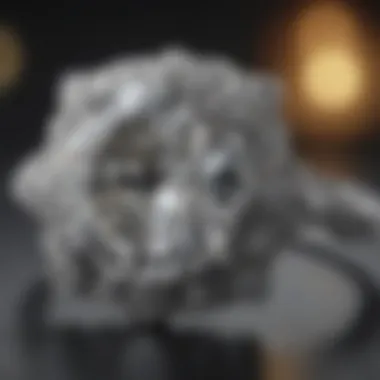
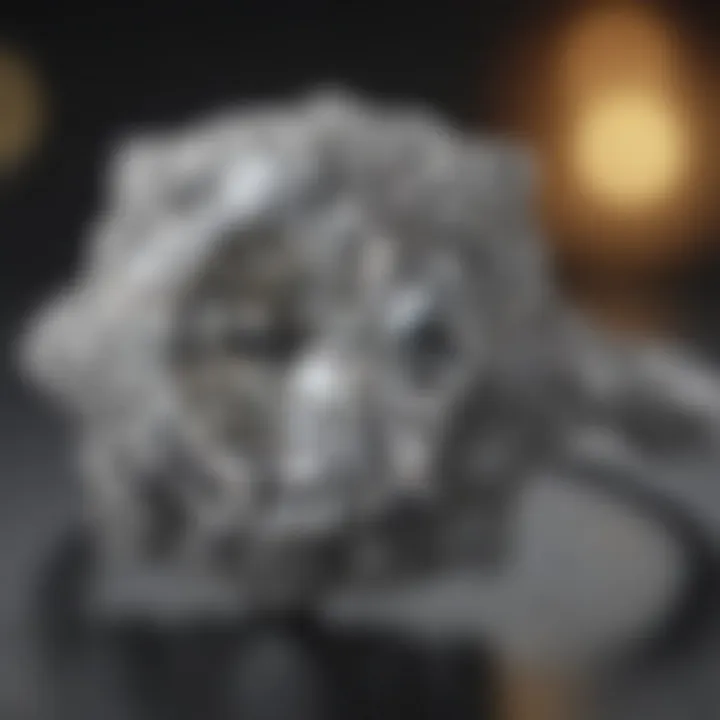
Intro
Diving into the world of diamond stone setting may feel like entering a labyrinth of opulence, craftsmanship, and history. It’s not just about the gem itself; it’s about the artistic touch that brings it to life. This journey will unravel the thick tapestry of diamond stone setting, from its ancient roots to the modern nuances of the craft. Enthusiasts, collectors, and jewelry designers will find an abundance of insights as we venture deeper.
Gemstone Overview
Definition and Origins
Diamonds, often dubbed as nature's finest jewels, are formed under immense heat and pressure deep within the Earth. While many may associate diamonds with luxury and romance, their story is much deeper and more complex. Each stone carries with it a piece of history, forged over billions of years. The art of setting these incredible stones takes skill, patience, and a refined eye for detail.
In terms of definitions, diamond stone setting involves the techniques used to secure diamonds into various types of jewelry, such as rings, earrings, or pendants. It's a melding of art and science that elevates a mere stone into a personal token of elegance.
Historical Significance
Historically, diamonds have held an esteemed place in human culture. They were revered not just for their beauty, but for their purported mystical properties. Ancient civilizations believed that diamonds could bring good fortune and protect the wearer. In lapidary art, which focuses on the cutting of gemstones, diamond settings have evolved significantly.
From simple prong settings used by medieval jewelers to the intricate pave techniques popular in the Renaissance, the journey of diamond setting reflects shifts in societal values and artistic expression. The craftsmanship of today honors that rich heritage while introducing new styles and methods.
"Every diamond tells a story. It's the setting that narrates it to the world."
Gemstone Properties
Hardness and Durability
One of the most celebrated properties of diamonds is their hardness, rated as a perfect ten on the Mohs scale. This makes them exceptionally durable and resistant to scratches. When setting a diamond, understanding its hardness is crucial; it influences the choice of setting style and ensures the stone can withstand daily wear without compromising its sparkle or integrity.
Color and Clarity
The allure of a diamond lies not just in its brilliance but also in its color and clarity. While many boasters may showcase the sparkling clear stones, colored diamonds have gained popularity, reflecting personal taste and individuality. Clarity is another significant aspect, as it affects the overall aesthetic appeal.
Here are some primary factors concerning color and clarity:
- Color: Ranges from colorless to shades of yellow, brown, and even rare hues like blue or pink.
- Clarity: Evaluates the visibility of internal flaws (inclusions) and surface blemishes, shaping the gem's beauty.
As we discuss these characteristics, it’s imperative to consider how craftsmanship ties into these properties. A skilled jeweler knows how to highlight a diamond's qualities, making it stand out even more.
This introduction sets the stage for a deeper dive into the various techniques and design considerations that come into play in diamond stone setting. As we move ahead, each detail will paint a clearer picture of the intricate dance of artistry and craftsmanship in the world of gemstones.
Historical Context of Diamond Stone Setting
Understanding the historical context of diamond stone setting is like peeling away the layers of an onion; there’s more depth than meets the eye. This segment not only highlights the artistry behind each sparkling stone but also reveals the cultural narratives that have shaped diamond craftsmanship over centuries. Knowing how diamond setting has evolved across different eras gives enthusiasts and jewelers vital insights into current practices and future trends.
Ancient Techniques and Traditions
Long before diamonds became a symbol of luxury, they were regarded for their supposed mystical powers. In ancient India, diamonds were set in talismans to ward off evil spirits. The techniques used back then were quite rudimentary. Artisans used simple tools, relying heavily on their experience and instincts. The peril of losing a diamond, whether during setting or wear, was a concern as much as it is today.
One fascinating method from the olden days is the "tension setting." Jewelers would create a mount that captured the gem in a way that made it appear to float. This technique was particularly prominent in ancient Persia, where the light play within the diamond was thought to connect with celestial bodies. Techniques varied from place to place, but the core objective remained the same: to elevate the diamond and let its natural brilliance shine forth.
Evolution Through the Ages
As time marched on, diamond stone setting techniques began to reflect technological advancements and shifts in societal values. The Renaissance marked a pivotal shift; jewellers started utilizing more sophisticated methods, such as the cutting techniques that would drastically improve the diamond's refractive qualities.
In the Victorian era, diamonds became the focal point of romantic jewelry, with intricate settings that showcased not just the diamond but also the artistry of the jeweler. The introduction of the bezel and prong settings during this time made it possible to mount larger stones securely while allowing light to enter from more angles, enhancing sparkle.
As the industrial revolution took hold, new machinery enabled mass production of jewelry, yet artisanal stone setting continued to thrive. Today, these traditional skills coexist with modern innovations, ensuring the diamond remains a beloved gem throughout diverse cultures.
Cultural Significance of Diamonds
In many cultures, diamonds symbolize strength, love, and purity. Ancient Greeks believed diamonds were tears of the gods; in many societies, they signify everlasting love, hence their prevalence in engagement rings.
"Diamonds are forever" encapsulates this notion beautifully, representing not just a gem, but an emotional commitment that transcends time.
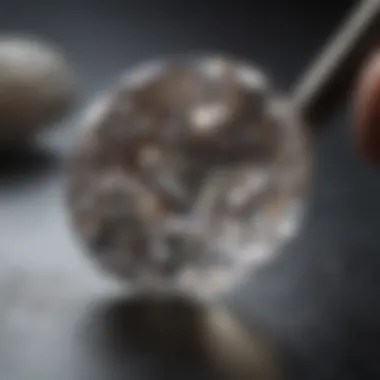
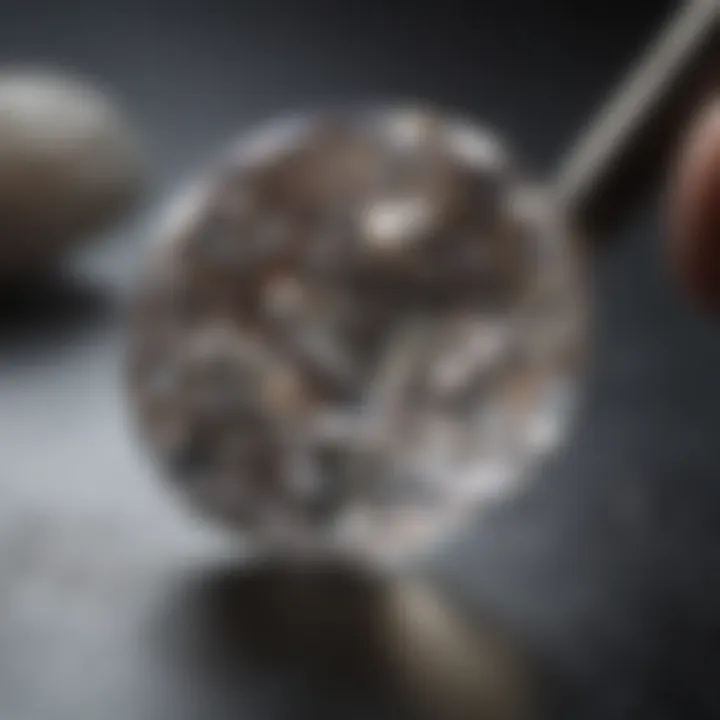
Throughout history, diamonds have also been linked to power and status. Royalty adorned themselves with diamond-studded crowns, signifying authority and opulence. In recent years, ethical considerations have reshaped how diamonds are viewed, as consumers increasingly seek conflict-free gems that carry a story of responsibility and sustainability.
To sum up, the history of diamond stone setting is a rich tapestry interwoven with tradition, artistry, and cultural significance. Each piece crafted tells not just of a local style, but also of global influences and evolving values in society. Understanding these layers contributes to a deeper appreciation of any jewelry piece that incorporates these magnificent stones.
Understanding Diamond Properties
In the realm of diamond stone setting, comprehending the properties of diamonds is crucial. These properties not only influence the aesthetic appeal of a piece but also define its value and overall desirability. Understanding the fundamentals of diamonds can dramatically enhance one's ability to choose the right stones for setting, ensuring the final piece meets both emotional and financial expectations.
The Four Cs of Diamonds
The Four Cs—cut, color, clarity, and carat weight—serve as a framework that underpins the grading of diamonds, making them essential for anyone involved in diamond setting.
Cut
Cut refers to how a diamond's facets interact with light, affecting its brilliance and fire. The way light is reflected and refracted can make or break the visual impact of the stone. A well-cut diamond will exhibit exceptional sparkle. The most optimal cuts often include round brilliant, princess, and emerald, each contributing differently to the overall finish. A diamond that is cut too shallow or too deep can lose some of its light, resulting in reduced visual appeal. Ultimately, a refined cut is often seen as the cornerstone of any quality diamond setting, providing the necessary dazzle that captivates the eye.
Color
While many may treasure colorless diamonds, color in the diamond world refers to how much tint a diamond has. The ideal and most sought-after colorless diamonds fall under grades D to F. However, diamonds can exhibit a range of hues that contribute to their uniqueness. Lesser grades may appear light yellow or brown, which can diminish their allure. Still, the colored diamonds touting shades like pink, blue, and green have carved out their niche, commanding even higher prices due to their rarity. In setting diamonds, color can drastically change the overall statement a piece makes, guiding everything from choice of metal to the design style.
Clarity
Clarity measures the presence of inclusions and blemishes within or on a diamond's surface. Ratings range from Flawless (no inclusions visible under 10x magnification) to Included (inclusions visible to the naked eye). Clarity matters in diamond stone setting as it directly affects both value and appearance. A clear diamond will sparkle brightly, whereas one with noticeable inclusion may appear duller. Jewelers often favor clarity because it not only reflects quality but also enhances the brightness and allure of the stone set into any piece of jewelry.
Carat Weight
Carat weight indicates the size of the diamond and how much it weighs. One carat equals 200 milligrams. Bigger diamonds are usually rarer and thus more expensive. However, carat weight alone doesn't determine a diamond's beauty. A well-cut smaller diamond can appear more striking than a poorly cut larger diamond. Consideration of carat weight in the design process also helps in balancing the overall look of the piece, ensuring that it fits comfortably and looks visually pleasing without overwhelming the wearer’s hand or neck.
Types of Diamonds
Beyond understanding the Four Cs, it’s essential to grasp the types of diamonds available. Each type carries its characteristics, making some more suitable for certain designs or personal preferences.
Natural Diamonds
Natural diamonds are formed deep within the Earth under high-pressure conditions over millions of years. Respected for their purity and physical properties, they generally hold a premium market value. Collectors often prefer these stones for their provenance and unique geological formation, essentially telling a story that captures attention. However, they may come with significant financial implications, which can be a consideration for budget-conscious jewelry enthusiasts.
Synthetic Diamonds
Synthetic, or lab-grown diamonds, are created through artificial processes that mimic natural conditions. They offer a more wallet-friendly option for those looking for diamond properties without the hefty price tag. These diamonds boast identical physical and optical characteristics to natural diamonds, making it difficult to discern between the two without specialized equipment. The rising popularity of synthetic diamonds speaks to a growing consumer preference for ethical sourcing, although some still perceive them to lack the emotional resonance of their natural counterparts.
Fancy Coloured Diamonds
Fancy coloured diamonds are a standout in the jewel world. Their unique hues—ranging from vivid yellows to deep blues—draw enthusiasts keen on making bold statements. The rarity of specific colors elevates their value significantly, particularly when they boast intensity and saturation. However, the whimsical nature of these diamonds often means they are best paired with unique settings to properly showcase their color, adding both aesthetic and monetary value to a piece of jewelry.
Understanding these properties, from the Four Cs to the various types of diamonds, is fundamental for anyone involved in diamond stone setting. This knowledge not only informs choices but also enriches the overall experience of creating or purchasing diamond jewelry.
Diamond Stone Setting Techniques
The world of diamond stone setting encompasses an array of techniques that are crucial in transforming the raw beauty of diamonds into exquisite pieces of jewelry. Understanding these techniques is not simply about aesthetics; it intermingles art and science, ensuring that each setting not only enhances the stone's brilliance but also secures it for wear. Each technique carries its own unique benefits and considerations, influencing the overall design and durability of the piece.
Prong Setting
This technique features small metal claws that hold the diamond securely. The prong setting is widely favored for its ability to allow maximum light penetration, causing the stone to sparkle intensely. Typically, four or six prongs are used to ensure stability without overwhelming the diamond's natural beauty. While effective, one must consider that the exposed edges can sometimes lead to snagging with clothing. Regular maintenance is paramount to ensure the prongs remain intact and the stone remains secure.
Bezel Setting
Bezel setting wraps the diamond snugly in a metal rim, providing a contemporary look. This method is appreciated for its security as it completely encases the stone, making it less susceptible to damage. Added to that, this style can enhance the size of the diamond visually, giving an illusion of a larger stone. However, one downside is that the extensive metal can partly obscure the diamond's facets, offering less light exposure compared to the prong setting.
Pavé Setting
In the pavé style, small diamonds are set closely together, creating a continuous sparkle effect. This intricate technique requires exceptional skill, as each tiny diamond must be set with precision to ensure a flush appearance. The pavé setting is perfect for those who desire a glam and heavily adorned look without focusing solely on a single stone. While stunning, it can pose challenges for cleaning and maintenance due to its detailed structure.
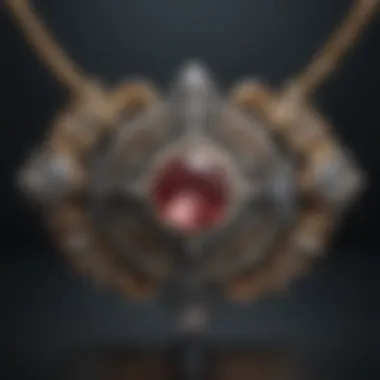
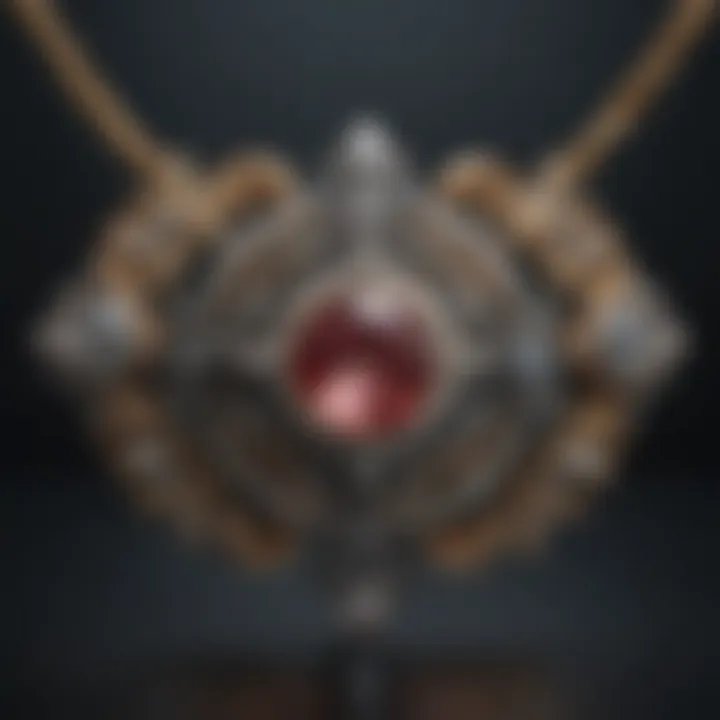
Channel Setting
Channel setting consists of rows of diamonds secured between two parallel metal bands. This design is celebrated for its modern and elegant appeal, as it protects the diamonds from snagging. It is particularly popular in wedding bands, showcasing a seamless sparkle around the entire band. Still, be cautious about the wear and tear; grit and dirt can accumulate in the channels, requiring periodic cleaning to maintain its luster.
Tension Setting
Unique in its use of pressure to hold the diamond in place, tension setting creates an illusion of weightlessness. The diamond appears to float between two prongs. This innovative setting style can yield stunning visual results, allowing for light to enter from every angle. However, one should note the increased risk of the diamond falling out if the ring experiences significant pressure or impact. Therefore, it is vital for the wearer to understand and be mindful of their activities to prevent incidents.
Each of these techniques not only showcases the diamond's attributes but also illustrates the jeweler's artistry and skill. By combining these settings with thoughtful design considerations, jewelers can create enamoring pieces that tell a captivating story, full of history and craftsmanship.
"A diamond is a piece of charcoal that handled stress exceptionally well."
To explore more intricate details on each of these techniques, consider diving into resources like Britannica or Wikipedia.
As we move through this craft, it is essential to appreciate that every technique has its place, each telling a unique story and offering its one-of-a-kind brilliance.
Design Considerations in Diamond Setting
When it comes to diamond stone setting, the details are paramount. Design considerations encompass a wide array of aspects, including the choice of materials, balancing aesthetics with functional security, and providing opportunities for personalization. All these factors play a crucial role in enhancing both the visual appeal and the longevity of the piece. Understanding these considerations can elevate a simple jewelry item into a statement of artistry and individuality.
Choosing the Right Metal
Choosing the right metal for a diamond setting can significantly impact both the appearance and durability of the piece.
Gold
Gold is one of the most enduring choices for diamond settings due to its rich hue and relatively malleable nature. Its key characteristic lies in its adaptability; gold comes in various karats, with higher karats offering a more vibrant yellow color due to less alloy content. This makes gold a beneficial choice for passionate jewelry designers and enthusiasts aiming for a luxurious look. However, gold is softer compared to other metals, making it susceptible to scratches. Thus, while it provides a warm and inviting tone, it may require more care to maintain its beauty over time.
Platinum
Platinum stands out as a premium metal, revered for its weighty feel and unparalleled durability. The primary characteristic of platinum is its resistance to tarnish and wear, ensuring that diamonds remain securely set in their bezels for years to come. As such, it becomes a popular choice for those wanting to guarantee long-lasting security for their precious stones. One unique feature of platinum is its hypoallergenic properties, making it ideal for individuals with sensitive skin. On the flip side, its higher price point might deter some, but many find it well worth the investment for its robust nature and elegance.
Silver
Silver presents a more accessible alternative while still hosting its own charm. A key characteristic of silver is its bright and shiny finish, offering a refreshing aesthetic appeal. As an affordable choice, it's a go-to for both new jewelry lovers and those looking to create unique designs without breaking the bank. Despite its affordability, silver tarnishes quickly, necessitating regular polishing to maintain its luster. This aspect often categorizes silver as a less durable option compared to gold or platinum. In diamond settings, designers frequently opt for silver for cost-effective pieces, but the trade-off in security and maintenance can sometimes dim its allure.
Balancing Aesthetics and Security
In the realm of diamond setting, it is essential to strike a balance between aesthetics and security. While creating a visually striking piece is important, ensuring the diamond is securely held is non-negotiable. For example, a pavé setting creates a stunning illusion with a vast expanse of diamonds, but it needs to be crafted carefully to prevent any of them from becoming loose or missing. Aesthetic beauty without secure craftsmanship can turn into a costly mistake. Therefore, careful thought regarding the design, stone selection, and setting technique is crucial for achieving harmony between the two.
Personalization and Customization Options
Today’s jewelry market thrives on personalization. Custom diamond settings allow individuals to express their unique stories—be it an engagement ring reflecting a couple’s journey or a family heirloom passed down through generations. Designers often explore different patterns, motifs, and finishes, providing options that resonate deeply with clients. By offering customizable elements, such as engraving or stone arrangement variations, jewelers can transform a piece into a reflection of its owner’s personality, ensuring it carries sentimental value for years to come.
"A well-designed diamond piece should always tell a story around its creation, ownership, and personal significance."
Through thoughtful design considerations, diamond stone setting can evolve beyond mere ornamentation into a celebration of artistry, identity, and durability.
Craftsmanship in Diamond Stone Setting
The artistry of diamond stone setting is not just about placing gems into metal; it's about creating a vision that harmonizes beauty and durability. Craftsmanship plays a pivotal role in how diamonds are showcased, ensuring that their brilliance shines through. Every facet, every detail must be carefully considered, making the jeweler's skill absolutely essential in this intricate process. A master jewelers’ touch can elevate the perceived value of a piece, turning a simple item into a treasured heirloom.
The Role of a Master Jeweler
In the world of diamond setting, the master jeweler is akin to an artist with a blank canvas. Their expertise goes beyond mere technical skill; it embodies an understanding of design principles, material properties, and gemology. A master jeweler possesses an in-depth knowledge of the types of settings that best complement specific diamond cuts and sizes, ensuring a marriage of form and function. For instance, using a classic prong setting for an exceptionally cut round diamond enhances its sparkle, while a bezel setting might be ideal for a more unconventional shape, lending a unique flair to the piece.
The jeweler's intuition for balance and proportion makes all the difference. They can assess how light interacts with different shapes and surfaces, adjusting their techniques accordingly. Their hands have been trained to delicately tackle even the most challenging settings, combining both precision and artistry. In essence, a crafted piece tells a story far richer than just its monetary value—it embodies the jeweler's skill, tradition, and passion.
Tools and Equipment Used
Setting Tools
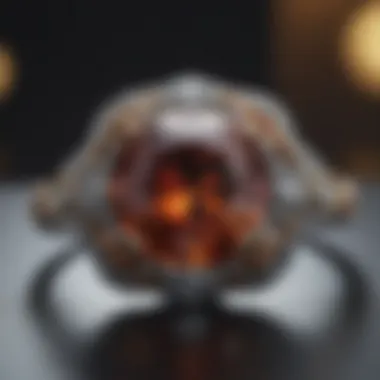
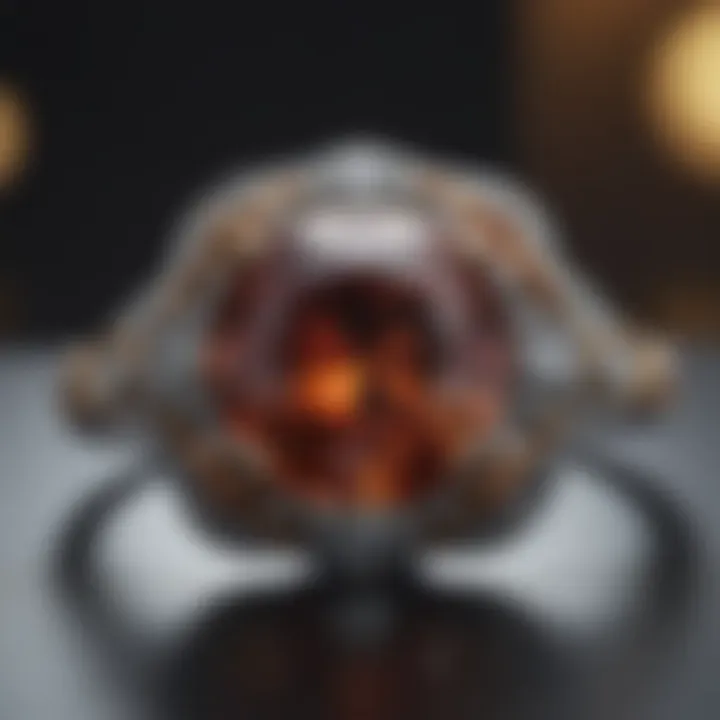
Setting tools are fundamental to the diamond setting process. They allow jewelers to exert precise control when securing a stone within its mount. A prominent characteristic of these tools is their variety: from claw lifters that help lift prongs to make room for the diamond, to pusher tools that ensure the stone is tightly secured. This versatility makes setting tools an indispensable part of any jeweler's toolkit.
One unique feature of setting tools is their ergonomic design, which helps to reduce hand fatigue during extensive work. This aspect is particularly beneficial when dealing with intricate or time-consuming settings, allowing for prolonged periods of precision work without compromising quality. However, it’s important to note that improper use of these tools can lead to damage, either to the diamond or the metal, underscoring the need for training and experience.
Polishing Tools
Polishing tools are vital for finishing a piece, ensuring that it shines and sparkles, revealing the hidden beauty of both the diamond and the setting. The key characteristic of polishing tools lies in their adaptability—different finishing pads and compounds can be employed based on the metal type and desired finish. Jewelers often use polishing wheels and buffing compounds to achieve a mirror-like surface on gold, silver, or platinum.
These tools introduce a lovely sheen, enhancing the overall appearance of the jewelry. A unique advantage of using modern polishing equipment is its efficiency. However, if overused, it can lead to surface scratches, reminding jewelers to balance speed with care. Just as in any form of art, there is a fine line between enhancing and damaging the craft.
Gravers
Gravers are specialized tools that allow jewelers to engrave and create intricate designs on metal surfaces, adding unique flair to diamond settings. A key characteristic of gravers is their sharpness, which enables precise, detailed work. Jewelers often use gravers to add personal touches or patterns that make a piece truly special, turning an ordinary ring into a bespoke masterpiece.
The unique feature of gravers is the ability to create not only designs but also secure the stone in place through techniques like channel setting. While gravers are beneficial for creating detailed work, they require a steady hand and immense focus; a single slip can tarnish a finely crafted design, making skill paramount.
Importance of Precision and Detail
When it comes to diamond stone setting, precision can’t be overstated. The slightest misalignment can disrupt the entire aesthetic of a piece, detracting from the allure of the diamond itself. Jewelers often work under magnification to ensure that details are meticulously executed. This focus on precision not only enhances the visual appeal but also ensures the longevity of the piece. A well-set diamond is less likely to become loose or damaged, protecting the investment made by the owner.
In addition, paying attention to detail can make a significant difference in how a piece is perceived. Subtle features, such as how well the metal complements the diamond's color or the evenness of a setting, contribute to an overall impression of quality and care. Mastering the details, through endless practice and a keen eye, allows jewelers to craft pieces poised to become timeless treasures.
Common Challenges in Diamond Setting
Diamond stone setting is an art, no two ways about it. The expertise involved in crafting and securing diamonds within jewelry pieces is paramount, and just like any precious craft, it doesn’t come without its hurdles. Understanding these common challenges can significantly enhance the decision-making process for both practitioners and enthusiasts alike.
Managing the Risk of Damage
When it comes to setting diamonds, the possibility of damage is a lurking concern. Not only are diamonds themselves hard, ranking a 10 on the Mohs scale, but they are also prone to chipping or breaking if not handled carefully. A slip of the hand can lead to a disaster.
One critical element in managing this risk involves proper tooling. Using the right tools can minimize contact with the gemstone and reduce the chance of mishaps. Hand tools like precision pliers and setting burrs allow for more control during the setting process. Moreover, securing diamonds with bezel or prong settings can also help shield them from incidental impacts.
Additionally, a thorough understanding of the diamond's anatomy can also come in handy. The pointed tip of a round cut diamond, known as the culet, is particularly delicate and must be treated with care. Jewellers often rely on techniques that involve initial tests to ensure that the diamond can withstand handling.
Ensuring Proper Fit and Longevity
As important as securing the diamond is, ensuring it fits well within the design is crucial for long-term durability. A diamond that’s improperly set can not only look out of place but might also loosen over time, risking both the gem and the piece itself.
To ensure a snug fit, jewellers typically focus on precision measurements of both the diamond and the mounting it’s destined for. Considerations such as shank thickness and design can heavily influence the fitting process. Regular follow-ups and inspections help maintain the longevity of both the setting and the diamond. A good fit isn't merely aesthetic; it also resists wear and tear, which can occur over time.
In summary, the challenges in diamond stone setting require a careful mix of skill, experience, and attention to detail. Successfully navigating these hurdles not only enhances the beauty of diamond jewelry but also ensures its durability and lasting appeal.
"A master jeweler doesn’t just set a diamond; they create a harmonious relationship between the gem and its setting."
The intricacies of these challenges remind us why the expertise of professional jewelers is so vital. Each piece of diamond jewelry is not just an ornament; it's a testament to the artistry and precision that goes hand in hand when bringing a vision to life.
Future Trends in Diamond Stone Setting
As we step into an era brimming with innovation, the landscape of diamond stone setting is undergoing a metamorphosis. Keeping a keen eye on future trends is crucial for enthusiasts, collectors, and jewelry designers. The intricate dance between traditional craftsmanship and advancing technology promises to redefine how diamonds are set and perceived.
In this section, we'll delve into the two major focal points influencing these emerging trends: technological innovations in jewelry making and the growing importance of sustainability and ethical practices.
Technological Innovations in Jewelry Making
Today, technology is not just a buzzword; it’s become a cornerstone in diamond stone setting. From laser engraving to 3D printing, jewelers are leveraging new tools that enhance both precision and creativity.
- Laser Technology: Laser technology has revolutionized the way diamonds are set. It enables precise cuts, enhancing the stone's brilliance while minimizing the risk of damage.
- 3D Printing: This has opened avenues for designs that were once deemed impossible. Jewelers can create intricate settings or prototypes without the hefty price tag of traditional methods.
- CAD Software: Computer-Aided Design software has become a staple in modern jewelry design, offering a platform for virtual visualization before any physical work begins.
The implementation of these technologies doesn't simply enhance efficiency; it also invites a new wave of creativity, allowing for custom designs tailored to the unique taste of clients. Additionally, it helps maintain consistency in production, which is essential for larger-scale operations.
Sustainability and Ethical Considerations
In recent years, awareness surrounding the ethical implications of diamond sourcing has surged. Consumers now demand transparency and sustainable practices. This shift is prompting jewelers to rethink their sourcing strategies.
- Ethical Diamonds: Many are now turning to lab-created diamonds, a sustainable alternative that offers environmental benefits without sacrificing quality. These stones often possess the same physical and chemical properties as natural diamonds but come without the controversy linked to mining.
- Responsible Sourcing: Jewelers increasingly focus on acquiring diamonds from suppliers who adhere to ethical guidelines, ensuring that the stones do not fund conflict or harm communities.
- Recycled Materials: Using recycled metals in settings adds another layer of sustainability, appealing to a customer base that values eco-friendly practices.
By integrating sustainability into the diamond setting process, jewelers not only cater to the evolving preferences of consumers but also contribute positively to the industry’s image.
"As technology intertwines with sustainability, the future of diamond stone setting is not just about beauty, but also about responsibility."



